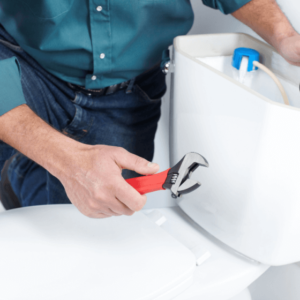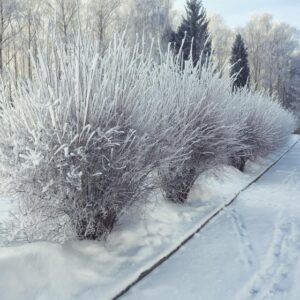A healthy and vibrant yard or garden is a plus for any homeowner and the best way to have one is to do it the natural, eco-friendly way. The EPA calls it greenscaping, a practice that improves the health and appearance of your landscape while preserving natural resources. It also saves time and money. Let’s take a look at how to “green up” your yard. Be sure to click on the Project Shopping List and check out what you need for eco-friendly gardening.
Keep Soil Healthy
To maintain an eco-friendly lawn or garden, you need to start with healthy, fertile soil. Soil can be loamy, sandy or clay. Loam is ideal because of its moisture retention and efficient drainage. Clay contains a lot of nutrients, but doesn’t drain as quickly as loam. Sand drains quickly, but doesn’t retain as many nutrients or as much water.
Pick up a handful of your soil and squeeze it. If it crumbles when you open your hand, you have loamy soil. If it doesn’t crumble, you have clay soil. Sandy soil will fall apart immediately. Knowing what kind of soil you have will help you figure out how much organic fertilizer and soil amendments you’ll need for a naturally successful crop.
Helpful Tip
Your soil’s acidity plays a big part in the success of your plantings, so you might want to do a pH test. You can pick up a pH test kit at your local True Value. Most plants grow best in soil with a neutral pH.
Decaying organic matter (mulch or compost) is a must for fertile soil because it fights erosion and provides a favorable habitat for beneficial organisms like earthworms. Compost neutralizes pH and supplies nutrients such as nitrogen and phosphorus. It also creates carbon dioxide as it decays, which helps plants absorb minerals from the soil. Without this, the soil cannot support healthy, thriving plants. Synthetic fertilizers can help, but plants grow better in naturally rich, nutrient-filled soil. Best of all, you can make compost yourself. See How to Compost Household Waste.
Mulch is organic material like chopped leaves, wood chips, compost or grass clippings that is spread to keep soil healthy in flower beds, gardens and lawns. It protects soil from the sun and holds in moisture. It also keeps out weeds and prevents erosion. You should add a thick layer (3″ maximum) of mulch in flowerbeds and around trees every year at the beginning of the growing season.
Aerating allows for greater movement of water, fertilizer and air. It also increases the speed of mulch decomposition and encourages deep root growth, so be sure to aerate before applying fertilizer. You can aerate your lawn with a hand cultivator or a mechanical aerator.
To aerate in a limited area, systematically dig holes in the soil with a spading or digging fork. Holes should be 2″ to 3″ apart and 1″ to 2″ deep. If you’re dealing with a larger area or you want to make the task easier, use a push spike aerator. Some models look like a manual push mower with spikes or star-shaped wheels instead of blades. Others are designed as attachments that fit behind a power mower.
Plant Native Plants
Part of creating an eco-friendly lawn and garden includes planting trees, shrubs, flowers, grass or vegetable species that are native to your region. And, because they are native plants, there is no need to use chemical fertilizers and enhancements. Native plant species are also beneficial to local wildlife, as they provide a healthy, natural habitat. Local plants can attract birds, butterflies and other animals for your enjoyment.
Helpful Tip
Use plants that are pest- and disease-resistant, to cut down on chemical insecticide use. Your local True Value hardware associates can show you which plants would work best for you.
Plant Trees
Trees improve our environment by moderating climate, improving air quality, conserving water and harboring wildlife. The more trees, the more resilient your eco-friendly lawn will be. Not only do trees provide summer shade and shield against harsh winds, but they also improve air quality by releasing oxygen and absorbing harmful pollutants.
For more in-depth details, see How to Paint a Tree.
Build a Rain Garden
Another way to support your eco-friendly garden is to build a rain garden, which is an area of ground planted with native grasses and wildflowers that self-irrigate by soaking up runoff from buildings and rooftops. These nontraditional gardens absorb 30% more water than the average lawn and are a beautiful addition to your yard.
To create a rain garden, determine what grasses and wildflowers are appropriate for your geographic area. Select an area that will catch the most runoff from your roof. Or place your rain garden in flat or low areas of your lawn so it absorbs rainwater that settles there. Dig a ground space from 3″ to 10″ deep with a shovel. Build in a high sun area and make sure the base of the garden is kept perfectly level. Need a little more advice? The friendly associates at your local True Value can help.
Helpful Tip
Place your rain garden away from the house to avoid leakage into the basement and at least 25′ from existing septic systems.
Minimize Water Waste
With typical foliage, only the top 8″ to 10″ of soil needs to be watered. To control the amount of water you use, install a seeper hose to produce a slow stream of water. You can also use cans for efficient water distribution. Punch holes in the bottoms of juice or coffee cans with a hammer and nail. Push the cans 6″ to 12″ into the soil (right side up) and fill them with water. The water will gradually seep from the bottom into the soil directly surrounding plant roots. This method will greatly reduce evaporation.
Helpful Tips
Watering deeply once a week conserves water and is more beneficial than lightly watering multiple times a week. Water your lawn early in the morning to minimize evaporation.
Grow plants with low water needs. Perennials such as mums or trilliums require less water than annual bedding plants. Colorful native plants are a great choice as well.
If you have outdoor contained plants, consider transplanting them to the ground where they’ll demand less water. Add hydrophilic polymer crystals that absorb water and release it slowly to plants over several days.
Installing a rainwater collection system at the end of your gutter downspouts controls excess surface water and collects it for irrigation of your lawn and garden. See Water Conservation: How to Build a Rain Barrel.
Use a Compost Bin
Composting is one of the most environmentally friendly gardening processes you can implement for your lawn and garden. It improves soil texture, suppresses weed growth, injects rich nutrients, decreases erosion and increases soil’s ability to absorb air and water.
To create a compost bin in your yard, choose a level spot about 3 x 5 square feet in size near a water source, but away from direct sunlight. Clear the spot of sod and grass using a sod cutter and set up a compost bin with chicken wire or concrete blocks. Add leaves, stalks, flowers, grass, vegetable scraps and coffee grounds from the kitchen (avoid using meat, dairy products or oils). Turn compost regularly with a pitchfork to distribute air and moisture and add water during dry spells. When the pile becomes dark, crumbly and uniform over a couple months, spread it in garden beds, under shrubs, or use it as potting soil. For more detailed information, see How to Make a DIY Compost Bin.
Use Eco-Friendly Products/Tools
Check your local True Value hardware store for green products like organic pesticide, fungicide, fertilizer and plant food. Organic products aren’t just safe for the environment; they can actually stimulate higher growth rates and enhanced root growth.
Try to avoid using any chemical pesticides and fertilizers. You can avoid the need for these chemicals by over-seeding your lawn. This helps keep weeds down and makes grass thicker. If you spot an occasional weed, dig it out at the root instead of applying chemicals.
Helpful Tip
The use of hand tools or electric tools is always more eco-friendly than using chemicals and gas-powered tools. Gas-powered tools consume fuel and can contaminate soil or water due to spills.
If you are not composting, collect clippings and yard debris in biodegradable lawn refuse bags instead of plastic trash bags.
Mow Right
Let your lawn grow out a bit before cutting it and cut every other week if possible. A lawn with taller grass keeps weed growth to a minimum and aids in drought resistance. Remember to keep the mower’s blade sharp and only mow when the grass is dry. Consider using a mulching mower — it creates a natural mulch and fertilizer layer that keeps your lawn healthy.
Install Solar-Powered Landscape Lighting
Installing solar lighting is an economical, energy-efficient way to highlight your home’s exterior architectural features. No special skills or tools are needed; most systems can be installed in under an hour using only a screwdriver. There’s no wiring to worry about and low voltage systems offer safety around children and pets, too. See How to Install Landscape Lighting.
It’s so satisfying to develop an eco-friendly lawn and garden. Enjoy yours the natural way!












